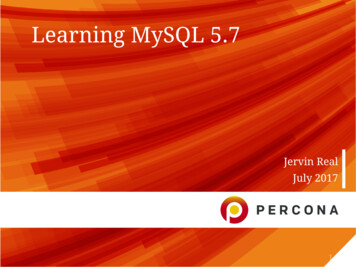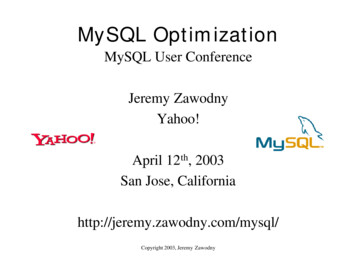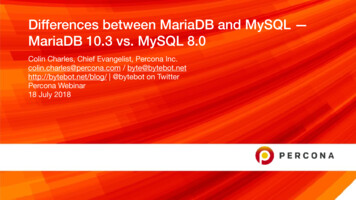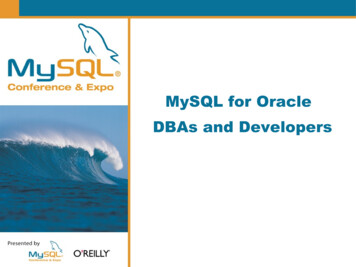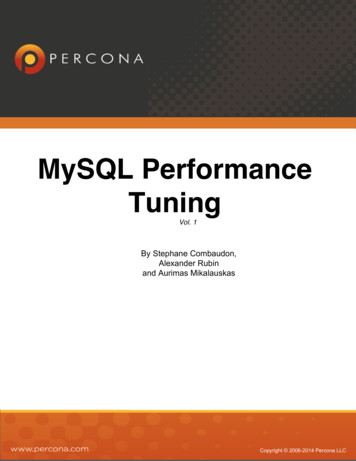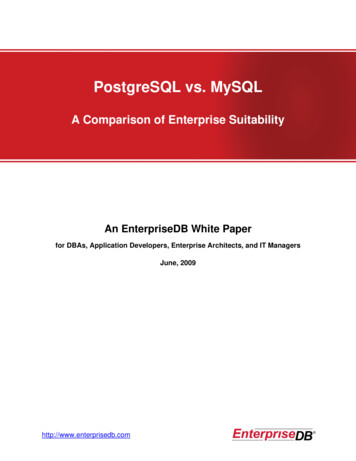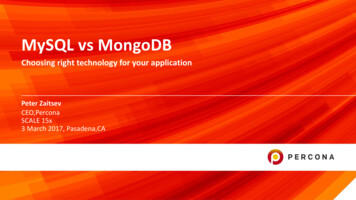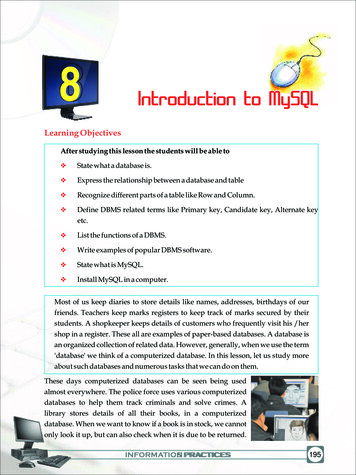
Transcription
P R A C T I C A LMySQL Performance OptimizationA hands-on, business-case-drivenguide to understanding MySQL query parameter tuning anddatabase performance optimization.
With the increasingimportance of applicationsand networks in both business and personalinterconnections, performance has becomeone of the key metrics of successfulcommunication. Optimizing performanceis key to maintaining customers, fosteringrelationships, and growing business endeavors.A central component to applications in any businesssystem is the database, how applications querythe database, and how the database respondsto requests. MySQL is arguably one of the mostpopular ways of accessing database information.There are many methods to configuring MySQLthat can help ensure your database respondsto queries quickly and with a minimum amountof application performance degradation.Percona is the only company that delivers enterpriseclass software, support, consulting, and managedservices solutions for both MySQL and MongoDB across traditional and cloud-based platforms thatmaximize application performance while streamliningdatabase efficiencies. Our global 24x7x365 consultingteam has worked with over 3,000 clients worldwide,including the largest companies on the Internet,who use MySQL, Percona Server , Amazon RDS for MySQL, MariaDB and MongoDB.
This book, co-written by Peter Zaitsev (CEOand co-founder of Percona) and Alex Rubin(Percona consultant, who has worked with MySQLsince 2000 as DBA and Application Developer)provides practical hands-on technical expertise tounderstanding how tuning MySQL query parameterscan optimize your database performance andensure that its performance improves applicationresponse times. It also will provide a thoroughgrounding in the context surrounding what thebusiness case is for optimizing performance, andhow to view performance as a function of thewhole system (of which the database is one part).THIS BOOK CONTAINS THEFOLLOWING SECTIONS:»»Section 1: Application Performance and UserPerception»»Section 2 (this section): Why is Your DatabasePerformance Poor?»»Section 3: MySQL ConfigurationFor more information on Percona, and Percona’ssoftware and services, visit us at www.percona.com.
AB0UT THE AUTHORSPeter Zaitsev, CEOPeter Zaitsev is CEO and co-founder of Percona. A serialentrepreneur, Peter enjoys mixing business leadership with handson technical expertise. Previously he was an early employee atMySQL AB, one of the largest open source companies in the world,which was acquired by Sun Microsystems in 2008. Prior to joiningMySQL AB, Peter was CTO at SpyLOG, which provided statisticalinformation on website traffic.Peter is the co-author of the popular book, High PerformanceMySQL. He has a Master’s in Computer Science from LomonosovMoscow State University and is one of the award-winning leadersof the world MySQL community. Peter contributes regularly to thePercona Performance Blog and speaks frequently at technical andbusiness conferences including the Percona Live series, SouthEastLinuxFest, All Things Open, DataOps LATAM, Silicon Valley OpenDoors, HighLoad and many more.Alexander Rubin, Principal ConsultantAlexander joined Percona in 2013. Alexander worked with MySQLsince 2000 as a DBA and Application Developer. Before joiningPercona he was doing MySQL consulting as a principal consultantfor over seven years (started with MySQL AB in 2006, then SunMicrosystems and then Oracle). He helped many customers designlarge, scalable and highly available MySQL systems and optimizeMySQL performance. Alexander also helped customers design bigdata stores with Apache Hadoop and related technologies.
Why is Your DatabasePerformance Poor?
Practical MySQL Performance Optimization2WHY IS YOUR DATA PERFORMANCE POOR?To achieve great application performance, you often musttroubleshoot performance problems. To do this, you need tounderstand what causes poor performance in the first place.Correctly understanding the true cause of performance problemsallows for a quick and efficient resolution—yet often this crucialinformation is lacking. Not fully understanding the root cause ofpoor performance means that the solution could require moretime and resources than are necessary, or that the solution usedto address the problem isn’t the most efficient one. For example,throwing more hardware resources at a performance issue mayincrease performance, but it doesn’t address the performance issueitself. It’s important that your solution isn’t just a way to mask theproblem, but actually resolves it.Why is Your Data Performance Poor?
Poor Architecture Design andImplementation
Practical MySQL Performance Optimization4POOR ARCHITECTURE DESIGN ANDIMPLEMENTATIONPerformance problems often stem from either poor architecturedesign, or poor design implementation. Architecture-basedperformance issues are a worst case scenario, because they arevery expensive to change. With poor implementation issues, thearchitecture-level ideas might be sound but get badly implementedin the code. Implementation issues are usually easier to address.The biggest architecture design problem is picking the wrongarchitecture for the scale of your application. If you’re designinga small scale application, you might do very well with MySQLalone—no caching, sharding or replication needed. At “Facebook”scale however, the same functionality will require these and manymore techniques. Understanding the scale of your application andchoosing the right architecture can be the difference betweensuccessful performance or failed performance.Another common problem is using MySQL for tasks it isn’t goodat. The world of databases, even open source databases, is a lotdifferent now than ten years ago. You don’t need to suffer anymorewith MySQL’s built-in, full-text search functionality—you canuse ElasticSearch or Sphinx. No more writing scripts to processportions of your log files on many replicas, and then aggregatethe results—you can use Hadoop or Vertica for that. Redis ,MongoDB, Cassandra and others all have excellent sweet spots,which is why we often see systems running at scale using morethan one database system.This isn’t necessarily a cause for over excitement, however.Combining different database systems (and different componentsin general) means the whole system itself becomes morecomplicated. Each system requires skills in development andPoor Architecture Design and Implementation
Practical MySQL Performance Optimization5operations, which is hard for smaller teams to master and maintainat a reasonable depth. We should listen to Albert Einstein, who said“Everything should be made as simple as possible, but not simpler.”Applying this principle, you should use MySQL (or anotherdatabase system) where it works reasonably well, and add othersystems (especially complicated ones) only if it helps to achievesignificant gains. Following online rumors that “Technology X isbetter at Y” is a bad idea when designing databases.The following example is a good illustration. I visited a customerwho was storing logs in MySQL. One of their developers heardthat Cassandra was much better for storing logs. I asked themhow many records are they going to store, and they told me some10,000 a day. At this small scale, any solution would work just fine. Iadvised them to stick with MySQL. Six months later I visited themagain. We needed to examine those logs to get the history for somediagnostics. It turns out they ignored my advice and implementedCassandra for log storage. The problem was the only developerwho knew Cassandra had since left, and they had no way ofretrieving those logs for us to analyze.A special note here: it is natural for engineers, both in developmentand operations, to want to play with shiny new technologies (it’spart of the innovative value they bring to any organization). Leavingthis tendency unchecked, however, can result in a menagerie ofincompatible technologies that bring chaos to your applications.You need to have a cool-headed gatekeeper who can objectivelyevaluate when the risk of adding new technologies is balanced bythe rewards. Giving engineers time to look at such technologiesas a “searchlight” effort might help to reduce their tendency toinstantly put everything into production.Poor Architecture Design and Implementation
Practical MySQL Performance Optimization6Finally, I should mention the database schema. The database oftenrequire major changes to applications. You need to ensure thatthe database schema does more than represent the data you needpresented—it must also efficiently perform the operations yourapplications require. This applies to both reads and writes, either ofwhich can become bottlenecks.Over time, application requirements are going to change: new datameans new features get added and old ones removed. Often asthis evolution occurs, you are under production constraints anddon’t have the time for proper database design. Instead, you areoften faced with “duct-taping wings on a pig” to get it to fly. Manyof these ad hoc solutions can get databases off the ground, and Iwould even go so far as saying a very large number of applicationswe use daily are powered by such “flying-pig” databases. However,I wouldn’t say they fly very well. It is important to take a hard lookevery so often at your database schema, and honestly evaluate ifit is still optimal for your requirements. It never hurts to performsome cleanup and do some optimization. This will not onlyimprove performance, but will make applications easier to developand maintain—increasing both development and operationsproductivity.Poor ImplementationWe’ve just shown some examples of poor application design.What about implementation? There are many ways to introducechaos by doing the right things, but in the wrong way! Even a goodschema can employ bad queries that don’t use indexes, use toomany queries, or have queries that fetch too much data. Let’s lookat a couple of examples.A problem we often encounter is developers thinking about thedatabase like it’s a “data store” inside their application: if they needPoor Architecture Design and Implementation
Practical MySQL Performance Optimization7a chunk of data, they go ahead and order it from the database. Thismeans that if an application is going to present a table, for example,it issues separate queries for every cell in the table. A much bettersolution typically is to have one SQL query retrieve the entire table.An application loop is a typical example of the above. In theapplication, we see something like this: id 1;while ( id 1000000) {.select * from table where id id .}This will end up running one million queries, which is significantlyslower than running one query to get the whole table. Themain reason for the delay is the high overhead of a single queryexecution: MySQL will need to receive the SQL query, parseit, then read the index, then send the result and then do it allover again for the next query. Even if each query is fast (e.g.,one millisecond) the total amount will add up to be one millionmilliseconds, or approximately 16 minutes. It is much faster to readthe whole table in one shot.Note. Sending the whole table to the application could be a baddesign as well. It is fine when the application function requires acache, but otherwise it is probably more efficient to come up witha query that filters or processes data inside MySQL and avoidssending the results back to the application.Another example of bad design implementation is using MySQLfor things you could do in your application. We’ve seen things likegetting the current date, time, converting the timezone and otherPoor Architecture Design and Implementation
Practical MySQL Performance Optimization8activities done on the database side using queries, when theycould just as easily be done on the client side (without impactingperformance).Fetching too much data from the database can be anotherproblem. I’ve seen people run queries like:“SELECT * FROMDESC”topscores ORDER BY scoreto fetch the top ten scores. This query fetches more than the topten scores. It fetches all the scores, orders them, presents the topten and then discards the rest. MySQL, unlike other databases,always provides full query results in cases like the above. Evenworse, the result might get sent to the client in its entirety andbuffered completely in the client’s memory.Don’t do this! If you only need ten rows, use the LIMIT command.I find that developers often have a hard time understanding querylatency, or accounting for it properly. Many developers work ontheir laptops, where latency from the application to the databaseis much lower than in a production environment. If you are runningyour application in the data center with a 1Gb network, one switchbetween your application server and a MySQL server, the expectedlatency added by the network should be about 300 microseconds.If the MySQL server responds instantly, it takes the client 300microseconds to get a response. This sounds pretty fast! And itis, as long as your page load or user interaction has a reasonableamount of queries. However, we have seen web pages that requireup to 100,000 queries.Poor Architecture Design and Implementation
Practical MySQL Performance Optimization9(Yes! 100,000 queries for just one page to load!)Do the math: even if all these queries are simple, the page will takeat least 30 seconds to load!Poor DeploymentEven if it is well-designed and implemented, you must also deploya system correctly. A lot of deployment issues are trivial: usingthe wrong hardware, the wrong instance type in the cloud, usingan inappropriate amount of memory or spinning disks (spinningdisks—yuck!) instead of flash-based storage: these types of issuesare all typically caught quickly and easy to resolve.Network-related issues are the biggest cause of most deploymentrelated issues. In other words, not thinking completely throughnetwork latency and network throughput.Even in the same data center, adding multiple switches and someslow firewalls between the application server and the databasecan multiply latency. When you place the database server andapplication/web server in different availability zones, or especiallyin different data centers, the increase gets even more dramatic.I remember a case where we observed very poor performancefrom one application. The application and MySQL servers weren’theavily loaded. Naturally we suspected the network was theculprit. When we asked about the network topology, the customertold us that “the connection between the application server anddatabase is 1GB.” As we pressed for more details, we learned thiswas a dedicated 1GB link between two data centers located morethan 100 miles apart (not a local 1GB connection as we assumed—reminding us once again never to assume anything).Poor Architecture Design and Implementation
Practical MySQL Performance Optimization10Note on the network speeds. It is important to understand thedifference between network bandwidth versus network throughputversus network latency. In the above case, 1GB is the networkbandwidth. This is the maximum rate of data that the channel candeliver, all things being equal. Network throughput is the actualrate of data delivered, taking into account the inhibitors to the dataflow. Network latency is the delay between sending and receivingthe data.A good analogy for network bandwidth, throughput, and latency isa highway. A good interstate highway may be six lanes wide (1GBbandwidth) and have the ability to move six trucks worth of “cargo”at 75 miles per hour. But if the highway is in poor condition, thatspeed will be reduced (throughput), and if the distance betweenthe two points is very far (100 miles) the delivery time may besignificantly longer even if we run six big trucks at the same time(latency).Network latency will rapidly spike, and make response times worse,both in cases of network error (such as packet loss) or networksaturation. Even a 0.1 percent packet loss rate is a big deal! If yourapplication is sensitive to latency, don’t use the network at morethan 50 percent of capacity.Network performance can vary a lot, especially in the cloudand other cases of software defined networking (SDN), wherethe exact network topology can be very fluid. It’s always best tomonitor the network latency between your database server andclient, so that you can quickly see any unusual latency increases.The simplest tool to measure network latency is a ping tool:Poor Architecture Design and Implementation
Practical MySQL Performance Optimization11root@ts140i:/var/lib/mysql# ping -c 5 -s 50010.11.13.1PING 10.11.13.1 (10.11.13.1) 500(528) bytes ofdata.508 bytes from 10.11.13.1: icmp seq 1 ttl 64time 27.1 ms508 bytes from 10.11.13.1: icmp seq 2 ttl 64time 21.6 ms508 bytes from 10.11.13.1: icmp seq 3 ttl 64time 21.6 ms508 bytes from 10.11.13.1: icmp seq 4 ttl 64time 21.4 ms508 bytes from 10.11.13.1: icmp seq 5 ttl 64time 21.4 msThese results are from a wireless network, so we’re observing alatency (response time) of 21ms (which would be extremely highfor a data center environment).Note. I’m using the -s parameter to specify the packet size. Youcan set this parameter to your typical query response size to seemore relevant latency. The 64 bytes default packet size is smallerthan most typical MySQL query/responses.To identify how many routing devices stand between yourapplication server and database, use the “traceroute” command:Poor Architecture Design and Implementation
12Practical MySQL Performance Optimizationroot@ts140i:/var/lib/mysql# traceroute10.11.13.1traceroute to 10.11.13.188 (10.11.13.188), 30hops max, 60 byte packets1 test (10.11.13.188)0.314 ms0.322 ms0.359 msIn this case, we can see that “test” was directly accessible, withouthaving to go through any routers. The traceroute command won’tshow you how many switches are in between the application serverand the database, or show you more complicated details—such asif tunneling or a VPN use.For interactive network latency observations, the “mtr” tool is veryhelpful. It combines the function of ping and traceroute in thesame tool.Another contributor to unexpected latency increases is the use ofsecure socket layer (SSL) with MySQL. SSL is wonderful for addingsecurity, however it drastically increases latency times (especiallythe time it takes to connect to the MySQL server). If you enableSSL, remember to account properly for the latency impact on yourdatabase queries. Maintaining persistent connections might be anespecially good idea when SSL is in use.Now let’s talk about network bandwidth. While latency issuesare often clearly visible, network bandwidth issues are oftennot. In most cases, when it comes to database activity we seelow bandwidth usage under a typical load, but a huge spikeduring batch jobs (which retrieve a lot of data and becomenetwork bound) or backup runs (often taking up lots of networkbandwidth). The best way to spot these instances of latencyPoor Architecture Design and Implementation
Practical MySQL Performance Optimization13due to bandwidth consumption is to set up and employ propermonitoring.It’s important to note that it’s not just the last hop between yourswitch and database server that can be saturated—it could also becore links in your data center. We have often seen backups startedon all hosts at the same time, which would saturate the networklink to the filer responsible for storing the backups.It’s situations like the above that demonstrate why cooperationbetween teams is key for capacity planning. To plan effectively,you need to understand both the objective requirements and theoperational data—which is only achievable through a full transferof information between the responsible parties. In far too manycases, we’ve found it extremely difficult for DBAs to get realinformation about the network topology or network statistics fromthe routers and switches.If network bandwidth becomes the issue, good solutions areupgrading to faster network speeds or aggregating several existingconnections. Using dedicated links for management traffic (suchas backups) is another option. Both of these require planning andpotential changes to network configuration.As a DBA you have a couple of options completely in your control.First, you can control timing. Don’t run a huge number of batchjobs concurrently. Start backups at different times and withdifferent hosts, and don’t run batch jobs and backups at the sametime.Second, consider using compression to reduce the amount ofbandwidth required for backups. If you’re using streaming, you canalso use the “pv” tool to set the rate limit.Cloud platform and virtualization add their own share ofdeployment issues, with the first being that it is a sharedPoor Architecture Design and Implementation
Practical MySQL Performance Optimization14environment and the performance profile of everything rangingfrom the CPU, to disk IO, to the network configuration canchange. Cloud and virtualization systems attempt to isolate andreduce performance variance from its neighbor’s noise, but noneof them are perfect. Typically, your best response is to plan fornormal performance variance. In extreme cases, you might need tophysically isolate some applications in virtualized environments, ormove to different instances with a cloud provider.Another issue we often see is improper technology use. Forexample, we had one customer who had set up Percona XtraDB Cluster in a virtualized environment where all the nodes endedup on the same physical host. So much for availability! In cloudenvironments, it’s important to note that there’s no guarantee youwon’t end up with the same issue—unless you explicitly requestinstances in different availability zones.Poor Software ConfigurationPoor software configuration is another issue that causes all kinds ofproblems ranging from application performance to downtime, andcan include data corruption and data loss.The configuration of any software components could be importantto performance, and the problems caused by misconfiguredsoftware are too numerous to cover fully. Most components aregoing to be correctly configured most of the time, but just onemisconfiguration might cause huge problems.From the application standpoint, a misconfigured driver is acommon MySQL-related issue. Configuring a Java connection poolto be too small, for example, can often cause low performance andapplication errors. Setting it too large, on the other hand, can causeconnection errors, poor performance or even crashes. SettingPoor Architecture Design and Implementation
Practical MySQL Performance Optimization15the wrong isolation mode in the connection settings, withoutunderstanding the implications, can cause the application to workincorrectly and potentially cause data corruption.On the MySQL side, one mistake is simply running MySQLwith the default settings. For historical reasons MySQL was notdesigned to automatically take on all resources of the physical hostor virtual instance. It was in fact designed to take on very little ofthem on purpose. This means if you run MySQL with the defaultsettings, you won’t be able to open many MySQL connections—causing poor performance. You need to configure MySQL correctlyto optimize performance. We will cover MySQL configurationadvice in greater detail later.You can also misconfigure other software componentsparticipating in MySQL interactions: we’ve seen issues caused by amisconfigured DNS, HProxy, load balancer, virtualization softwareor the Linux kernel. Unlike MySQL, the Linux kernel provides avery decent default configuration and requires extra tuning only formost unusual or demanding applications.Poor Data DesignData design issues are a very common cause of problems. Datadesign problems can be the source of both the most significantgains (we’ve seen up to 1000 times performance improvementsin extreme cases) and the most significant cost to fix. This is whywe strongly suggest getting a second opinion about data design—whether you’ve chosen Percona or someone else to address yoursetup.Data design is a complex subject that is so closely connected tooverall application architecture that the boundaries between thetwo are not very clear. For this discussion, we’ll lump decisionsPoor Architecture Design and Implementation
Practical MySQL Performance Optimization16related to what technologies you use—for example where touse MySQL and where to use Hadoop—and other “big picture”questions such as sharding, replication architecture questions,queries and schema as “data design questions.”When designing your schema you need to consider what kind ofdata you’ll be getting, how much data, what kind of distributionit will need, as well as what operations you’re going to be doingwith it. Simply looking at your application’s objects and theirrelationships, and mapping them to database schema, rarelyproduces optimal designs for the application. Quite often youneed to implement data normalization or denormalization, deployhorizontal or vertical partition or use other techniques. Whendeciding what combination of indexes is going to work well foryour mix of queries, you’ll need to consider how to optimize readqueries without slowing down writes too much. You also need todecide what it looks like to have “too many” indexes.Finally, you need to examine your queries and understand in eachcase when running that particular query is the most efficientway to get the job done. Some optimizations are obvious: usinga multi-row insert statement instead of performing 1000 singlerow inserts (especially outside of the transaction). Or running onequery to fetch all data from the table instead of running a queryfor each cell. Other decisions are more complicated—you need tounderstand the MySQL optimizer and execution engine abilitiesfor the version you’re using, and which queries it can run efficientlyand which it can’t.The biggest mistake we see is just “following your gut,” or takingapproaches that worked with other databases and transportingthem directly to MySQL. Learning how to use the EXPLAINcommand in MySQL will help you understand which queries areeffective and which aren’t.Poor Architecture Design and Implementation
Practical MySQL Performance Optimization17The EXPLAIN command can be hard to read on its own, especiallyfor complicated queries. MySQL Workbench is a free tool thatincludes a Visual Explain feature, which helps you to easilyunderstand how a query is executing.Note. Query performance is highly dependent on data size, datadistribution and specific constants that are present in the query.Both the execution plan and the execution time can be completelydifferent. This means that you need to validate performance on areal data set and with a variety of data (not just perform the sameaction on the same data over and over again).Many problems result from developers designing and testingapplications with very small and artificial data sets, and developingapproaches that don’t scale at all. If you do not have access to realdata (e.g., you’ve never launched the application), come up witha means for generating artificial data to cover some worse casescenarios.Query performance does not necessarily change linearly with datasize. Depending on your queries and indexing, multiplying the datasize by ten might cause query performance to change by 10 or 1000percent!This is why it is very important to establish a data retention policyas soon as possible. How long you store the MySQL data is notterribly important: a range from six months to three years is fairlytypical. Archiving the data does not mean that you remove thedata for good. After setting the data retention policy, we can usethe pt- archiver tool (part of the Percona Toolkit ) or some typeof custom script to remove the data from the main MySQL serverand place it into an “archive” system. You can use another MySQLinstance, or even Apache Hadoop, for longer term data storage.Poor Architecture Design and Implementation
Practical MySQL Performance Optimization18It is also possible to convert data to CSV files and store it onAmazon Web Services S3 so that the data will be available for ondemand data analysis. You can also use the “archive” systems fordata analysis. At the same time, if the archived data is inserted inanother MySQL instance, it can be used by applications.For example, a bank may need to show a statement to a user (alist of all bank operations). Let’s say the statement normally goesback only one year. If the user needs to see older statements(beyond one year), the user can select a “view archive” button. Theapplication will then connect to an “archived” MySQL instance.The bottom line is that a single MySQL server is usually notintended to store terabytes of data: this is the domain of Big Data.In the Big Data world (e.g., Hadoop), data is stored in a cluster andspread across multiple machines. Having a data retention policycan significantly increase application performance, saving time andreducing the cost of maintenance tasks like backup.If you are using sharding, you might need to address another datarelated problem: shard disbalance. Typically this problem originatesfrom poor sharding design choices: sharding on something like thefirst letter of name (which gives us a far from uniform distribution),or mapping so many users to a single shard that there is not enoughcapacity to handle the amount of per-user information growth overtime.As with other data design issues, it is good to test things with realdata if possible (or as realistically-generated data as you can get).In any case, it is typically impossible to avoid disbalancecompletely. While trying to reduce disbalance issues, you need toensure you also have a solution for shard rebalancing that you canimplement when needed.Poor Architecture Design and Implementation
Pra
MySQL AB, one of the largest open source companies in the world, which was acquired by Sun Microsystems in 2008. Prior to joining MySQL AB, Peter was CTO at SpyLOG, which provided statistical information on website traffic. Peter is the co-author of the popular book, High Performance MySQL. He has a Master's in Computer Science from Lomonosov

